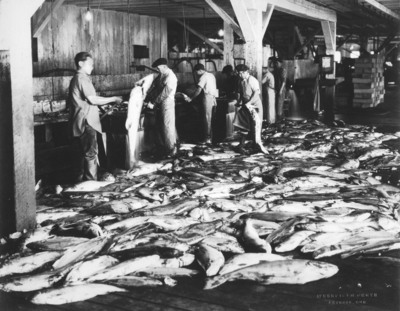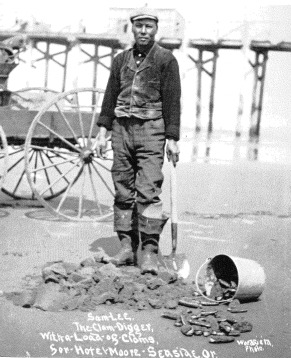Employment
Chinese immigrants were known to be efficient, hard-workers and were considered cheap labor since they were paid less than white workers, meaning greater profits for their employers.
Employment opportunities for Chinese laborers in Oregon included working as miners, canners, railroad workers, farmers and ranch hands, and businessmen. The Chinese workforce in Oregon had a significant impact and lasting on the state’s economy and landscape.
Mining
Beginning in the 1850s, Chinese immigrants began work to wherever gold was discovered; by the 1870s there were over 2400 Chinese miners in Oregon, mostly in the Jackson and Josephine Counties. These workers accounted for 60 percent of the total mining workforce in the state. Due to discriminatory practices, Chinese were often not allowed to work on certain white mining claims and so they began "reworking" abandoned locations. When hydraulic mining reached Oregon, it was predominantly the Chinese that dug the canals which provided the water supply to make the technology effective.
Railroads
In the 1860s, Oregon began to build and plan for major rail lines to make transportation easily accessible both within the state as well as to Washington and Northern California. By the 1870s hundreds of Chinese laborers were hired via contract from California and China to work on the hundreds of miles of railroad construction.
Agriculture
Oregon agriculture during the second half of the 19th century would not have progressed as quickly and successfully without the Chinese hired to clear the land; care for crops such as wheat, hops, and a variety of fruits; and use their expertise to grow produce for market sales. In Eastern Oregon the Chinese also worked as hog farmers, sheepherders, cowboys, and ranch hands.
Business
Throughout the state a number of Chinese men became successful entrepreneurs. In Eastern Oregon Lung On, a businessman, and Ing Hay, a doctor, partnered and worked out of the Kam Wah Chung building in John Day. During the early 1900s in Astoria, there were a number of Chinese-owned businesses including the Lum Quing Grocery Store, established by the brothers Lum Quing and Lum Sue, and a restaurant that sold food from China, opened by Ah Dogg. In Portland one of the earliest Chinese businesses recorded, in 1851, is the Tong Sung House, a boarding house and restaurant.

Canneries
The Chinese community grew rapidly in Astoria beginning in the mid-1870s due to job opportunities in canneries. Work at a cannery included cutting, sorting, and canning salmon harvested from the Columbia River. However, within the next few decades, the population decreased slightly due to discriminatory immigration laws. Another slight decrease occurred during the late 1910s and early 1920s due to several reasons including: a decline in the salmon population, a large 1922 fire in the city, and the implementation of automated packing equipment.
Photograph: Laborers slicing salmon in an Astoria cannery. Courtesy Clatsop County Historical Society #5613.330

Other Occupations
The Chinese workforce in Oregon consisted of variety of jobs including:
- house menservants
- day laborers
- shopkeepers
- sharecroppers
- grocers
- labor contractors
- bakers
- cooks
- laborers in iron,
wood, and paper mills
Photograph: Sam Lee, a resident of Seaside, owned a laundry and is shown here digging for clams.
Courtesy Chinese Consolidated Benevolent Association
